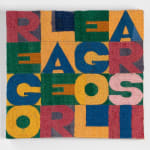
Alighiero Boetti Italian, 1940-1994
Regola e Regolarsi, 1979
Embroidery
22.5 x 23.5 cm. (8 7/8 x 9 1/4 in.)
Copyright The Artist
Further images
Alighiero Boetti’s Regola e Regolarsi (1979) belongs to the Arazzi series, begun in 1971 after his first visit to Kabul, Afghanistan. These embroideries consist of hand-stitched grids of coloured squares,...
Alighiero Boetti’s Regola e Regolarsi (1979) belongs to the Arazzi series, begun in 1971 after his first visit to Kabul, Afghanistan. These embroideries consist of hand-stitched grids of coloured squares, each containing a letter that, when deciphered, reveals a phrase or aphorism. The present work, translating as “Rule and Regulate”, crystallises Boetti’s preoccupation with systems and self-discipline, contrasting external structures with inner regulation.
The year 1979 marks a turning point in the Arazzi project. Until then, production was based in Kabul, but the Soviet invasion forced the relocation of embroiderers – mostly Afghan women – to refugee camps in Peshawar, Pakistan, where the work continued. This piece thus belongs to a transitional moment, both historically and in Boetti’s own engagement with his collaborators.
Regola e Regolarsi exemplifies the tension central to the Arazzi: the order of the grid against the disorder of unpredictable colour combinations chosen by the artisans; the authority of Boetti’s system against the freedom of handmade interpretation. The phrase itself underscores this duality, meditating on rules and self-regulation within a structure that is simultaneously controlled and open-ended.
The year 1979 marks a turning point in the Arazzi project. Until then, production was based in Kabul, but the Soviet invasion forced the relocation of embroiderers – mostly Afghan women – to refugee camps in Peshawar, Pakistan, where the work continued. This piece thus belongs to a transitional moment, both historically and in Boetti’s own engagement with his collaborators.
Regola e Regolarsi exemplifies the tension central to the Arazzi: the order of the grid against the disorder of unpredictable colour combinations chosen by the artisans; the authority of Boetti’s system against the freedom of handmade interpretation. The phrase itself underscores this duality, meditating on rules and self-regulation within a structure that is simultaneously controlled and open-ended.
